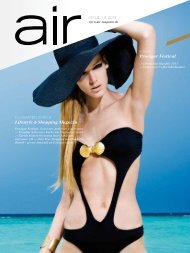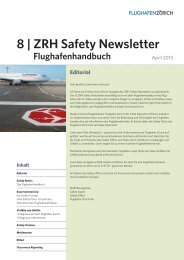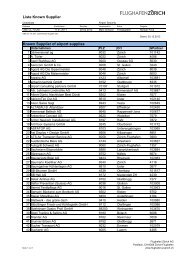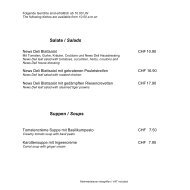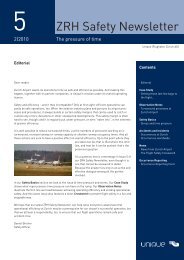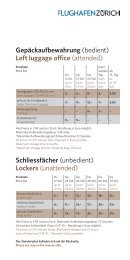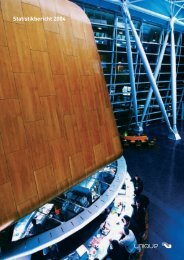Fixed Energy Systems for Aircraft at Zurich Airport
Fixed Energy Systems for Aircraft at Zurich Airport
Fixed Energy Systems for Aircraft at Zurich Airport
You also want an ePaper? Increase the reach of your titles
YUMPU automatically turns print PDFs into web optimized ePapers that Google loves.
<strong>Fixed</strong> <strong>Energy</strong> <strong>Systems</strong><br />
<strong>for</strong> <strong>Aircraft</strong><br />
<strong>at</strong> <strong>Zurich</strong> <strong>Airport</strong>
Content<br />
- 2 - <strong>Fixed</strong> <strong>Energy</strong> <strong>Systems</strong><br />
1 Introduction .......................................................................................................................3<br />
2 <strong>Zurich</strong> <strong>Airport</strong> Situ<strong>at</strong>ion......................................................................................................4<br />
3 Technical Description........................................................................................................5<br />
3.1 Pier E........................................................................................................................5<br />
3.1.1 Electrical System 400 Hz......................................................................................5<br />
3.1.2 Pre-conditioned Air System ..................................................................................6<br />
3.2 Pier A........................................................................................................................7<br />
3.2.1 Electrical System 400 Hz......................................................................................7<br />
3.2.2 Pre-conditioned Air System ..................................................................................8<br />
3.3 Pier B........................................................................................................................9<br />
4 System Oper<strong>at</strong>ion .............................................................................................................9<br />
4.1 <strong>Energy</strong> Production ....................................................................................................9<br />
4.2 Oper<strong>at</strong>ions ..............................................................................................................10<br />
5 <strong>Aircraft</strong> APU Oper<strong>at</strong>ional Restrictions .............................................................................11<br />
6 Economics of the System................................................................................................12<br />
7 Environmental Benefits ...................................................................................................13<br />
8 Annex..............................................................................................................................14<br />
8.1 Abbrevi<strong>at</strong>ions..........................................................................................................14<br />
8.2 References .............................................................................................................14<br />
Imprint<br />
Published by: Unique (Flughafen Zürich AG), P.O. Box, CH-8058 <strong>Zurich</strong>, www.unique.ch<br />
Environmental Services and Technical Facility Management<br />
[environment@unique.ch]<br />
D<strong>at</strong>e: March 2009<br />
St<strong>at</strong>us: Final / 2009-03_ZRH_<strong>Aircraft</strong>-FES.doc<br />
Key Words: APU – <strong>Aircraft</strong> – <strong>Airport</strong> – <strong>Fixed</strong> <strong>Energy</strong> <strong>Systems</strong> – <strong>Zurich</strong>
- 3 - <strong>Fixed</strong> <strong>Energy</strong> <strong>Systems</strong><br />
1 Introduction<br />
<strong>Aircraft</strong> during ground times <strong>at</strong> airports require electrical energy (115 volts <strong>at</strong> 400 Hz) and<br />
depending on the ambient conditions also pre-conditioned air (PCA) <strong>for</strong> he<strong>at</strong>ing or cooling of<br />
the cabin. Such energy can either be provided by the aircraft built-in APU (Auxiliary Power<br />
Unit) or typically by ground support equipment (GPU - Ground Power Unit, ACU - Air Clim<strong>at</strong>e<br />
Unit, mobile he<strong>at</strong>ing unit). In addition, fixed energy systems are installed and oper<strong>at</strong>ed by the<br />
airport or its tenants (table 1).<br />
Table 1: Ways of providing energy to the aircraft during ground times<br />
<strong>Energy</strong> <strong>Systems</strong> <strong>for</strong> <strong>Aircraft</strong><br />
<strong>Aircraft</strong> built-in APU Mobile Units <strong>Fixed</strong> <strong>Energy</strong> <strong>Systems</strong><br />
Electricity (400Hz) <br />
PCA (air) ( - ACU) <br />
MES (main engine<br />
start)<br />
( - ASU) ---<br />
Oper<strong>at</strong>ion of aircraft APU with its low efficiency r<strong>at</strong>e of 8-14% is subject to gaseous<br />
emissions and noise, thus often contributing significantly to the local air quality impacts and<br />
site noise impacts. To mitig<strong>at</strong>e emissions and noise, fixed energy systems can be designed<br />
th<strong>at</strong> provide electrical energy and pre-conditioned air to aircraft as depicted in figure 1.<br />
Figure 1: Basic layout of fixed energy systems
- 4 - <strong>Fixed</strong> <strong>Energy</strong> <strong>Systems</strong><br />
2 <strong>Zurich</strong> <strong>Airport</strong> Situ<strong>at</strong>ion<br />
Given the stringent environmental legisl<strong>at</strong>ion in Switzerland and the ambient air quality<br />
conditions in the area where <strong>Zurich</strong> airport is loc<strong>at</strong>ed, the airport authority has started as<br />
early as 1990 to design and implement air quality mitig<strong>at</strong>ion plans. Part of such mitig<strong>at</strong>ion<br />
plans have always been all activities associ<strong>at</strong>ed with the handling of the aircraft. This also<br />
includes the ground power delivery to aircraft during their ground time. To this end, <strong>Zurich</strong><br />
airport provides both st<strong>at</strong>ionary 400 Hz and PCA <strong>at</strong> all hard stands and mand<strong>at</strong>es the airlines<br />
to use the systems.<br />
The general airport layout is depicted in figure 2.<br />
E<br />
Figure 2: <strong>Zurich</strong> airport aircraft concourses and hard stands: Pier A, E, <strong>for</strong>mer/future B<br />
A<br />
B<br />
Reflecting the ambient and clim<strong>at</strong>e conditions of <strong>Zurich</strong> airport, the systems <strong>for</strong> preconditioned<br />
air are designed <strong>for</strong> the following:<br />
• Ambient conditions: Summer: +31°C, 80% humidity<br />
Winter: -11°C, 40% humidity<br />
• Cabin conditions: Summer: +26°C<br />
Winter: +21°C
3 Technical Description<br />
3.1 Pier E<br />
- 5 - <strong>Fixed</strong> <strong>Energy</strong> <strong>Systems</strong><br />
3.1.1 Electrical System 400 Hz<br />
Pier E went into oper<strong>at</strong>ion in 2003 and provides 27 g<strong>at</strong>es <strong>for</strong> aircraft handling. 16 g<strong>at</strong>es are<br />
<strong>for</strong> aircraft c<strong>at</strong>egories D and E (180 KVA) and 11 g<strong>at</strong>es <strong>for</strong> c<strong>at</strong>egory C (90 KVA). The st<strong>at</strong>ic<br />
converters are placed in the apron buildings. Depending on the stand size, one or two<br />
converters are available. The cable coils with 30 m cable are mounted underne<strong>at</strong>h the<br />
passenger loading bridge.<br />
The oper<strong>at</strong>ion of the system can be done through the aircraft plug or the switch board on the<br />
passenger loading bridge. For open handling, four pit systems are available.<br />
The system contains a monitoring and control unit with 2,500 d<strong>at</strong>a points. The system logs all<br />
oper<strong>at</strong>ing events and system errors and all important d<strong>at</strong>a can be analysed and evalu<strong>at</strong>ed.<br />
The temper<strong>at</strong>ures of the various phases are measured in the 400 Hz plugs and three g<strong>at</strong>es<br />
are equipped with measurement systems <strong>for</strong> the electricity.
Table 2: Technical d<strong>at</strong>a 400 Hz system Pier E<br />
G<strong>at</strong>es Pier E 27<br />
Comments<br />
16 x 180KVA<br />
11 x 90KVA<br />
Trans<strong>for</strong>mer st<strong>at</strong>ion 2<br />
1<br />
- 6 - <strong>Fixed</strong> <strong>Energy</strong> <strong>Systems</strong><br />
2 x 1,600 KVA<br />
1 x 700 KW (cooling)<br />
St<strong>at</strong>ic converter 90KVA 45 Total capacity 4.05 MVA<br />
Reserve <strong>for</strong> converter NLA<br />
(new large aircraft)<br />
4 2 g<strong>at</strong>es with 360KVA<br />
Cable coils 43<br />
PIT <strong>Systems</strong> 4<br />
3.1.2 Pre-conditioned Air System<br />
The air-conditioning units deliver warm or cold air to the aircraft fuselage depending on the<br />
requirements. The air units are placed on the apron and connected to the hose reels over a<br />
telescope pipe under the passenger loading bridges. The g<strong>at</strong>es <strong>for</strong> c<strong>at</strong>egory D and E aircraft<br />
have two hoses, the g<strong>at</strong>es <strong>for</strong> c<strong>at</strong>egory C aircraft one.<br />
The ice machines produce binary ice (flow-ice) during the night wich is stored in the energy<br />
storage unit. During actual oper<strong>at</strong>ions, the stored energy is sufficient <strong>for</strong> a standard day of<br />
oper<strong>at</strong>ion. This results in lower energy capacity requirements as peak hour demand has not<br />
to be met. Also, binary ice requires smaller transport pipes as the l<strong>at</strong>ent energy can be used.<br />
The g<strong>at</strong>es provide metering systems to monitor he<strong>at</strong> and ice consumption of individual<br />
aircraft types.
- 7 - <strong>Fixed</strong> <strong>Energy</strong> <strong>Systems</strong><br />
The he<strong>at</strong>ing and cooling energy is provided through two separ<strong>at</strong>e pipe systems <strong>at</strong> each g<strong>at</strong>e.<br />
This enables to he<strong>at</strong> or cool aircraft <strong>at</strong> the same time. All relevant d<strong>at</strong>a are displayed in the<br />
control system <strong>for</strong> analysis and evalu<strong>at</strong>ion.<br />
Table 3: Technical d<strong>at</strong>a PCA Pier E<br />
Ice machines (ammonium) 2<br />
Capacity<br />
2 x 410 KW<br />
Ice Storage<br />
1 220 m<br />
Stored <strong>Energy</strong><br />
3<br />
10,000 MWh<br />
He<strong>at</strong>ing Trans<strong>for</strong>mer 2 1,100 KW each<br />
Air Conditioning Units (two hoses) 16 12,000 m 3 /h<br />
He<strong>at</strong>ing capacity per unit 190 KW<br />
Cooling capacity per unit 225 KW<br />
Air Conditioning Units (one hose) 11 6,000 m 3 /h<br />
He<strong>at</strong>ing capacity per unit 80 KW<br />
Cooling capacity per unit 105 KW<br />
3.2 Pier A<br />
3.2.1 Electrical System 400 Hz<br />
Pier A went into oper<strong>at</strong>ion in 1985 and has a total of 18 stands <strong>for</strong> the handling of aircraft.<br />
When handling wide-body aircraft, the number of stands is limited to 13.
- 8 - <strong>Fixed</strong> <strong>Energy</strong> <strong>Systems</strong><br />
The production is central with three rot<strong>at</strong>ing 50/400 Hz converter th<strong>at</strong> are each switched on<br />
or off depending on the demand <strong>at</strong> the g<strong>at</strong>es. The distribution to the individual g<strong>at</strong>es is done<br />
via the 960 V grid. Each g<strong>at</strong>e is equipped with 90 KVA trans<strong>for</strong>mers and contains a 400 Hz<br />
cable with plug. For wide-body aircraft, a so called "Y"-cable is used th<strong>at</strong> distributes the<br />
electricity to both aircraft plugs.<br />
A specialty of the plant is the monitoring and control system with 1,500 d<strong>at</strong>a points. This<br />
control system logs all oper<strong>at</strong>ing events and system errors. All important d<strong>at</strong>a are trend<br />
analysed and evalu<strong>at</strong>ed.<br />
Table 4: Technical and oper<strong>at</strong>ional in<strong>for</strong>m<strong>at</strong>ion 400 Hz Pier A<br />
G<strong>at</strong>es Pier A 18<br />
Comments<br />
Built 1985<br />
Trans<strong>for</strong>mer St<strong>at</strong>ion<br />
Converter 300KVA<br />
Manufacturer<br />
3 Total capacity: 900 KVA<br />
Piller<br />
Distribution 960V / 400 Hz<br />
Currency Compens<strong>at</strong>ion G<strong>at</strong>e none<br />
Local Trans<strong>for</strong>mer 18 90 KVA<br />
3.2.2 Pre-conditioned Air System<br />
The pre-conditioned air system <strong>for</strong> Pier A as it is today went into oper<strong>at</strong>ion in 1998. Up to th<strong>at</strong><br />
time, air pressure compressors have been used <strong>for</strong> air-conditioning and main engine start.<br />
The system oper<strong>at</strong>es the same way as the one in pier E. However, pier A only offers one<br />
hose per g<strong>at</strong>e <strong>for</strong> air-conditioning. The air units have different capacities depending on the<br />
g<strong>at</strong>e size.
- 9 - <strong>Fixed</strong> <strong>Energy</strong> <strong>Systems</strong><br />
Table 5: Technical d<strong>at</strong>a PCA Pier A<br />
Number Capacity<br />
Ice Machines 2 2 x 475 KW<br />
Chiller Storage<br />
9<br />
Capacity<br />
1'050 KW<br />
Stored <strong>Energy</strong><br />
4 MWh<br />
He<strong>at</strong>ing Converter 2 900 KW each<br />
Air conditioning units (two hoses) 13 10,000 m 3 /h<br />
He<strong>at</strong>ing capacity per unit 190 KW<br />
Cooling capacity per unit 225 KW<br />
Air conditioning units (one hose) 5 5,000 m 3 /h<br />
He<strong>at</strong>ing capacity per unit 80 KW<br />
Cooling capacity per unit 105 KW<br />
3.3 Pier B<br />
Pier B went into oper<strong>at</strong>ion in 1975 and has 10 aircraft g<strong>at</strong>es. It is currently out of service <strong>for</strong><br />
major refurbishment and all 400Hz and PCA systems have been decommissioned. In<br />
previous years, some stands have still been used <strong>for</strong> long term parking of aircraft and five<br />
400 Hz system remained in oper<strong>at</strong>ion <strong>for</strong> this purpose.<br />
4 System Oper<strong>at</strong>ion<br />
4.1 <strong>Energy</strong> Production<br />
<strong>Energy</strong> is provided <strong>for</strong> all systems by the airport's central power plant. This energy plant is a<br />
combined he<strong>at</strong> and power co-gener<strong>at</strong>ion plant, consisting of four boilers with two steam<br />
turbines and one gas turbine with a total he<strong>at</strong> capacity of 120 MWth and 10 MWel. The plant is<br />
oper<strong>at</strong>ed with 90% compressed n<strong>at</strong>ural gas (since 1998) and 10% he<strong>at</strong>ing oil (light). It<br />
provides the whole airport with process energy and is optimised <strong>for</strong> oper<strong>at</strong>ional and<br />
ecological parameters.<br />
Electrical energy is taken from the public grid through two independent trans<strong>for</strong>mer st<strong>at</strong>ions.
- 10 - <strong>Fixed</strong> <strong>Energy</strong> <strong>Systems</strong><br />
4.2 Oper<strong>at</strong>ions<br />
The systems are owned and maintained by Unique (Flughafen <strong>Zurich</strong> AG) as part of the core<br />
infrastructure of the airport. The systems are oper<strong>at</strong>ed by the various handling agents. When<br />
an aircraft approaches the parking position, ground staff sets the chocks and hooks up the<br />
aircraft to external power <strong>at</strong> the same time. As such it is not necessary <strong>for</strong> the aircraft crew to<br />
run the APU upon approaching the stand in order to timely shut down the main engines.<br />
Power is switched from main engines directly to external.<br />
The technical availability of the system is >99% of all times. Both, the technical availability of<br />
the systems and the immedi<strong>at</strong>e service provided to the arriving aircraft are key to the<br />
acceptance by the flight crews and thus the effectivity of the system. Maximizing the use of<br />
the system and thus the ecological benefits is further enhanced by implemented and<br />
en<strong>for</strong>ced local regul<strong>at</strong>ions (cf. chapter 5).<br />
Average oper<strong>at</strong>ing d<strong>at</strong>a from 2004 to 2006 are listed in table 6. The average total LTO cycles<br />
were 133,500 per year.<br />
Table 6: Average annual oper<strong>at</strong>ing d<strong>at</strong>a <strong>for</strong> <strong>Fixed</strong> <strong>Energy</strong> <strong>Systems</strong> (2004-2006) and average 2005-2008 1<br />
Pier A Pier B Pier E Total<br />
Equipped g<strong>at</strong>es 18 5 27 49<br />
<strong>Aircraft</strong> cycles handled 30,000 400 31,000 61,400<br />
400 Hz Usage per g<strong>at</strong>e 1 8 h/d 1.5 h/d 6 h/d<br />
PCA Usage per g<strong>at</strong>e 1 1.1 h/d -- 1.6 h/d<br />
Billed hours 400Hz 43,000 h 3,000 h 60,000 h 106,000 h<br />
Billed hours PCA 5,300 h 0 h 16,000 h 21,300 h<br />
Electricity 400 Hz 1 1,300 MWh 300 MWh 2,000 MWh 3,600 MWh<br />
Electricity PCA 1 350 MWh 0 MWh 800 MWh 1,150 MWh<br />
Electricity Total 1 1,650 MWh 300 MWh 2,800 MWh 4,750 MWh<br />
He<strong>at</strong> consumption 200 MWh 0 MWh 300 MWh 500 MWh
- 11 - <strong>Fixed</strong> <strong>Energy</strong> <strong>Systems</strong><br />
5 <strong>Aircraft</strong> APU Oper<strong>at</strong>ional Restrictions<br />
Based on articles 36 and 51 of the Oper<strong>at</strong>ing License <strong>for</strong> <strong>Zurich</strong> <strong>Airport</strong> (of 1.6.2001), the use<br />
of auxiliary power units (APU) is subject to certain restrictions. These are laid down in the<br />
AIP LSZH, section AD 2:<br />
AIP SWITZERLAND 1<br />
LSZH AD 2<br />
2.21.2.5 Auxiliary Power Units (APU)<br />
Docking Stands<br />
Primarily, the st<strong>at</strong>ionary airport pneum<strong>at</strong>ic and electrical service units shall be used. Altern<strong>at</strong>ively,<br />
mobile units shall be used.<br />
Other stands<br />
For pneum<strong>at</strong>ic and power supply of aircraft not parked <strong>at</strong> docking stands, mobile units shall be<br />
used.<br />
APU shall only be started:<br />
• To start engine, but earliest 5 minutes be<strong>for</strong>e off-block time.<br />
• If maintenance work on the aircraft makes it unavoidable; in th<strong>at</strong> case the service period shall<br />
be kept as short as possible.<br />
• If the st<strong>at</strong>ionary or mobile units are not available or unserviceable <strong>for</strong> specific aircraft types. In<br />
th<strong>at</strong> case the APU shall be started <strong>at</strong> earliest 60 minutes be<strong>for</strong>e off-block time and kept in<br />
oper<strong>at</strong>ion not more than 20 minutes after the on-block time.<br />
In particular cases, the <strong>Airport</strong> Manager of the <strong>Airport</strong> Authority may permit longer service periods.<br />
Some airlines establish additional and company based procedures <strong>for</strong> the usage of APU.<br />
These procedures can be dependent on aircraft type, actual take-off weight and<br />
characteris<strong>at</strong>ion of the airport (altitude, runway length, etc).<br />
One airline oper<strong>at</strong>ing in and out of <strong>Zurich</strong> has established the following procedures (properly<br />
reflecting the airport's regul<strong>at</strong>ions):<br />
4. USE OF APU<br />
• Use of APU restricted.<br />
Use APU <strong>for</strong> ENG – start MAX 5 MIN be<strong>for</strong>e block off.<br />
If GPU U/S: Start APU MAX 60 MIN be<strong>for</strong>e block off.<br />
APU OPS MAX 20 MIN after block on.<br />
For A320 taxi-in without APU approved.<br />
• ACFT on hard stands: switch off APU when GND Power Unit (GPU) connected.<br />
• Terminal A/B: Preconditioned air and electrical power avbl.<br />
• <strong>Energy</strong> saving:<br />
The crew shall decide, depending on WX COND or technical requirements, whether air<br />
conditioning is required or not.<br />
Generally, the air conditioning system should be switched off with AOT of APRX 10°C to 25°C.<br />
The air conditioning system should also be switched off after PSGR have disembarked or be<strong>for</strong>e<br />
leaving the ACFT.<br />
1 31 OCT 2003 and AIRAC 15 APR 2004
- 12 - <strong>Fixed</strong> <strong>Energy</strong> <strong>Systems</strong><br />
6 Economics of the System<br />
The required investments <strong>for</strong> 400Hz/PCA systems designed and implemented <strong>for</strong> <strong>Zurich</strong><br />
airport are approxim<strong>at</strong>ely 1 million Swiss francs (CHF) per g<strong>at</strong>e; the costs are about 45% <strong>for</strong><br />
the 400 Hz systems and 55% <strong>for</strong> the PCA system. The costs generally vary depending on<br />
the required service level and the possibility to plan one comprehensive system r<strong>at</strong>her than<br />
upgrading an existing 400 Hz system with PCA.<br />
The costs of service vary according to the services required and the handling agent providing<br />
the service. By way of in<strong>for</strong>m<strong>at</strong>ion, table 7 gives an overview of the service charges <strong>at</strong> <strong>Zurich</strong><br />
airport.<br />
Table 7: <strong>Fixed</strong> system service prices <strong>at</strong> <strong>Zurich</strong> <strong>Airport</strong> (1.11.2008)<br />
<strong>Aircraft</strong> Group 400 Hz Electrical<br />
<strong>Energy</strong><br />
(CHF/hour)<br />
Pre-Conditioned<br />
Air<br />
(CHF/hour)<br />
Size A: RJ70, RJ100, B737, F70, F100, MD80 36.- 75.-<br />
Size B: A300, A310 ,A319/20/21, B757, B767 62.- 130.-<br />
Size C: A330, A340, B747, B777, MD11 87.- 190.-<br />
Charging Rules:<br />
0-10 min. no charge<br />
11-70 min. 1.0 hour (=minimum charge)<br />
71-100 min. 1.5 hours<br />
101-131 min. 2.0 hours<br />
131-160 min. 2.5 hours<br />
etc.<br />
APU oper<strong>at</strong>ing costs vary depending on the aircraft type, the APU type, APU fuel<br />
consumption and oper<strong>at</strong>ing times as well as fuel price and other APU oper<strong>at</strong>ing/maintenance<br />
costs. An approxim<strong>at</strong>ion <strong>for</strong> fuel costs <strong>for</strong> APU oper<strong>at</strong>ion only is given in table 8.<br />
Table 8: Approxim<strong>at</strong>ion of APU fuel costs (in CHF/h)<br />
<strong>Aircraft</strong> Group APU Fuel (kg/h) 2<br />
Fuel Price (CHF/kg) 3<br />
Fuel Costs (CHF/h)<br />
Short haul aircraft 107 1.40 150.-<br />
Long haul aircraft 240 1.40 336.-<br />
Comparisons:<br />
• A large aircraft (A330) using fixed 400Hz <strong>for</strong> 3 hours plus fixed PCA <strong>for</strong> 1 hour pays 451.-<br />
CHF <strong>for</strong> the service, while only the fuel costs <strong>for</strong> the APU over the same 3 hours are<br />
approxim<strong>at</strong>ely 1,000.- CHF.<br />
• A small aircraft (RJ100) using fixed 400Hz and PCA <strong>for</strong> 1 hour each pays CHF 111.- <strong>for</strong><br />
the service, while the fuel costs only <strong>for</strong> the APU are approxim<strong>at</strong>ely CHF 150.-<br />
2 ICAO Doc 9889, Version 1, Table A1.4.6<br />
3 IATA, Basis May 2008 (1,351 USD/mt)
- 13 - <strong>Fixed</strong> <strong>Energy</strong> <strong>Systems</strong><br />
7 Environmental Benefits<br />
The combin<strong>at</strong>ion of reliably providing electrical energy and pre-conditioned air while <strong>at</strong> the<br />
same time mand<strong>at</strong>ing the airlines to use the systems when technically available is key to<br />
achieve maximum ecological benefits.<br />
Already the specific emission reductions are considerable when comparing the CO2<br />
emissions per hour of oper<strong>at</strong>ion <strong>for</strong> an APU and the fixed energy system (table 9).<br />
Table 9: Specific CO2-emissions (kg/h)<br />
APU<br />
kg CO2/h<br />
FES<br />
kg CO2/h 1<br />
Shorthaul <strong>Aircraft</strong> 337 0.7<br />
Longhaul <strong>Aircraft</strong><br />
1<br />
Emissions from Swiss electricity production<br />
758 1.2<br />
The benefits of the fixed ground power systems are convincing: In 2007, the use of the fixed<br />
energy system has reduced the airport emissions by 86 t NOx and approxim<strong>at</strong>ely 44,000 t<br />
CO2 (equals almost 14,000 t of fuel worth 19.5 million CHF)<br />
Table 10: Emission reduction <strong>Zurich</strong> airport in 2007<br />
Total Movements<br />
Oper<strong>at</strong>ion with FES/GPU (actual)<br />
2007<br />
268,476<br />
Total <strong>Airport</strong> NOx 1,014 t<br />
APU NOx 21 t (2.1%)<br />
Total <strong>Airport</strong> CO2 305,340 t<br />
APU CO2<br />
Oper<strong>at</strong>ion with APU only (scenario)<br />
11,554 t (3.8%)<br />
Total <strong>Airport</strong> NOx 1,096 t<br />
APU NOx 103 t (9.4%)<br />
Total airport CO2 338,800 t<br />
APU CO2 45,000 t (13.3%)<br />
Total airport emissions include 4 :<br />
• Per<strong>for</strong>manced based aircraft emission with ICAO d<strong>at</strong>a;<br />
• Handling emissions (GSE, airside traffic, aircraft maintenance)<br />
• Infrastructure (energy plant, emergency gener<strong>at</strong>ors, airfield maintenance, construction,<br />
fire training)<br />
• Land side vehicle traffic (access traffic to airport within local perimeter of approx. 3 km)<br />
4 Calcul<strong>at</strong>ion methods <strong>Zurich</strong> airport 2008.
8 Annex<br />
8.1 Abbrevi<strong>at</strong>ions<br />
ACFT <strong>Aircraft</strong><br />
ACU Air Clim<strong>at</strong>e Unit<br />
AOT Ambient Outside Temper<strong>at</strong>ure<br />
APRX Approxim<strong>at</strong>e<br />
APU Auxiliary Power Unit<br />
ASU Air Starter Unit<br />
CHF Swiss Francs<br />
CO2 Carbon Dioxide<br />
ECS Environmental Control System<br />
EGT Exhaust Gas Temper<strong>at</strong>ure<br />
ENG Engine<br />
FES <strong>Fixed</strong> <strong>Energy</strong> System<br />
GPU Ground Power Unit<br />
GSE Ground Support Equipment<br />
hp Horsepower<br />
Hz Hertz<br />
ICAO Intern<strong>at</strong>ional Civil Avi<strong>at</strong>ion Organiz<strong>at</strong>ion<br />
IGV Inlet Guide Valves<br />
kW Kilow<strong>at</strong>t<br />
LTO Landing and Take-off Cycle (standard 4 modes)<br />
MES Main Engine Start<br />
NOx Oxides of Nitrogen<br />
mt metric ton<br />
MWh Megaw<strong>at</strong>t-hours<br />
OPS Oper<strong>at</strong>ions<br />
PCA Pre-conditioned Air<br />
PSGR Passengers<br />
V Volts<br />
WX COND We<strong>at</strong>her Conditions<br />
- 14 - <strong>Fixed</strong> <strong>Energy</strong> <strong>Systems</strong><br />
8.2 References<br />
AIP, 2004: Aeronautical In<strong>for</strong>m<strong>at</strong>ion Public<strong>at</strong>ion <strong>Zurich</strong> <strong>Airport</strong>. Unique (Flughafen <strong>Zurich</strong><br />
AG), <strong>Zurich</strong>, 2004.<br />
ICAO: Local Air Quality Guidance Manual, ICOA Doc. 9889 (1st Edition, 2007).<br />
Unique (Flughafen Zürich AG): Emission Charges <strong>Zurich</strong> <strong>Airport</strong>. Review 2003. <strong>Zurich</strong>, 2003<br />
Unique (Flughafen Zürich AG): <strong>Energy</strong> Management <strong>Zurich</strong> <strong>Airport</strong>. <strong>Zurich</strong>, 2005<br />
Unique (Flughafen Zürich AG): <strong>Aircraft</strong> APU Emissions <strong>at</strong> <strong>Zurich</strong> <strong>Airport</strong>. <strong>Zurich</strong>, 2005



